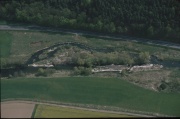Cölbe
Lahn Cölbe
Key features of the case study
The restoration measure at the river Lahn near Cölbe aimed to increase habitat heterogeneity as the river channels was straightened, bordered by fixed embankments and characterized by homogeneous substrate, depth and flow condition.
Site description
The restored section of the Lahn river is located in between Bad Laasphe and Marburg. Catchment size is about 650 km2, catchment geology is mostly comprised of acid rock (schist). Land use in the study catchment consists of up to 60% forest, around 30% pasture, and 10% urban areas (Corine land cover data, 2000). Besides this land use pressure, the Lahn river is affected by multiple pressures (Rabeni 2000) and potential source populations are rare or distant (Jähnig et al. 2009).
Objectives
The project aimed at increasing channel feature and habitat diversity (floodplain water bodies, gravel banks) and to initiate natural channel dynamics with successional patterns.
Measures selection
Measures at the site Lahn – Cölbe were applied on a river section of 240 m from September to October 2000. Bank fixations were removed to initiate bank side erosion with the intent of creating a constant sediment supply for downstream parts of the stream, which otherwise would start scouring. The channel patterns developed after substantial side erosion during floods. Boulders of the former bank fixation and deadwood trunks were put on the river bottom to increase habitat and flow diversity. Multiple channels were created doubling the overall width of active channels.
Ecological response
The project was not monitored by the organization which implemented the measures. However, the site has been intensively monitored in two research projects of the University of Duisburg-Essen (Jähnig et al., 2009; Januschke et al., 2014). Since data prior to restoration were not available, both authors used upstream non-restored sites as controls (“space for time substitution”).
Results of the biological monitoring carried out in 2004 and 2005 (4-5 years after implementation of the measures) reflect the hydromorphological changes in the restored site. The strong increase in the number of floodplain vegetation species is due to the creation of additional mesohabitats, while riparian ground beetles react mainly to the increased availability of the mesohabitat “gravel bar”. The small and insignificant response of benthic invertebrates to restoration measures is due to the comparatively small changes in aquatic microhabitat composition. Besides the differences between the morphological changes of meso- and microhabitats, differences between the organism groups may be due to different dispersal abilities and re-colonization potentials.
From 2005 to 2009, overall richness of floodplain vegetation species decreased. Changes in species assemblages revealed a strong shift to later successional processes. In contrast, richness of ground beetles increased. Assemblages, in 2005 dominated by riparian specialists characterized by high dispersal ability, were enhanced by species with differing habitat preferences (e.g. forest species, species with a preference for vegetated banks). Although restoration did not enhance assemblages of benthic invertebrates in 2005, some single species were supported that are associated to finer mineral sediments or known as good dispersers. Although instream microhabitat composition did not differ between 2005 and 2009, new single benthic invertebrate species appeared in 2009. Their presence reflected the enrichment of leaf litter due to the higher presence of trees and ongoing succession in the restored site 2009 and a time-delayed colonization of finer substrates.
Hydromorphological response
Results of the morphological monitoring carried out in 2004 and 2005 (4-5 years after implementation of the measures) show that mesohabitat diversity (e.g., channel side arms, bars) and the share of rare microhabitats did increase. However, the total number of microhabitats (the number of different substrate types) was similar to the non-restored sites. Between 2005 and 2009 microhabitat compositions did not change in both the non-restored and restored sites. In the floodplain, restoration strongly improved mesohabitat diversity. Many additional mesohabitats, e.g. gravel bars and flood-prone areas, were recorded in 2005. Temporal changes in the restored site from 2005 to 2009 were evident showing successional processes in riparian areas, e.g. decrease of gravel bars and increase of vegetated banks.
Monitoring before and after implementation of the project
The project was not monitored by the organization which implemented the measures. However, the site has been intensively monitored in two research projects of the University of Duisburg-Essen. The results, including monitoring results of another 4 sites have recently been published in Jähnig et al. (2009). Moreover, results of Lahn Cölbe and two another restored sections in the Lahn river focusing on temporal changes in morphological and biological conditions between 2005 and 2009 are published in Januschke et al. (2014).
In addition to morphological surveys, the following organism groups were investigated in 2004/2005 and 2009: benthic invertebrates,fish, macrophytes, floodplain vegetation, and ground beetles.
Contact person within the organization
Herbert Diehl, Regierungspräsidium Giessen, Abteilung Umwelt, Dez. 41.2, Oberirdische Gewässer/Hochwasserschutz, phone: + 49 641 303-4166, email: he.diehl@rpu-mr.hessen.de
Funding
Approximate costs: 111.000 Euro
References
Jähnig, S. C., Brunzel, S., Gacek, S., Lorenz, A. W. and Hering, D. (2009): Effects of re-braiding measures on hydromorphology, floodplain vegetation, ground beetles and benthic invertebrates in mountain rivers. Journal of Applied Ecology, 46, 406-416.
Januschke, K., Jähnig, S.C., Lorenz, A.W. & Hering, D. (2014) Mountain river restoration measures and their success(ion): effects on river morphology, local species pool, and functional composition of three organism groups. Ecological indicators 38: 243-255.
Related Measures
- Widen water courses
- Allow/increase lateral channel migration or river mobility
- Shallow water courses
- Initiate natural channel dynamics to promote natural regeneration
- Introduce large wood
- Remove bank fixation
- Recreate gravel bar and riffles
- Remove bank fixation
- Lower river banks or floodplains to enlarge inundation and flooding
- Remove hard engineering structures that impede lateral connectivity
